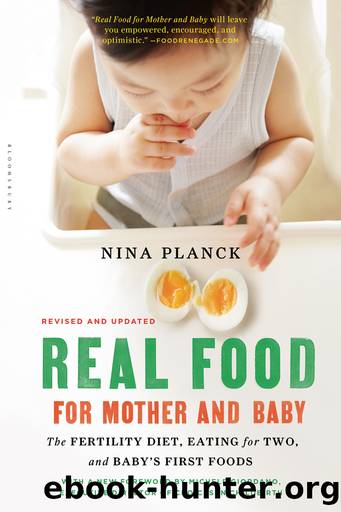Real Food for Mother and Baby by Nina Planck

Author:Nina Planck
Language: eng
Format: epub
Publisher: Bloomsbury Publishing Plc
Published: 2016-09-15T00:00:00+00:00
PR O - LIFE
Probioticsâmeaning âpro-lifeââare the good bacteria in your body and in real food. They populate the gut, where they aid digestion, produce neurotransmitters, and boost immunity, among other tasks. Gut flora are astonishingly productive workers. They create energy by breaking down the food you eat. They produce vitamin K2 and B vitamins. They keep the gut wall healthy. They train your immune system to identify and kill invaders. Many pathogens meet their maker in the gut before they make trouble in the rest of the body.
Though you can buy probiotics, the food business didnât invent these helpful little animals. The beneficial strains of Bifidobacteria and Lactobacilli occur naturally in raw milk, real yogurt, raw milk cheese, sauerkraut, and other traditional cultured and lacto-fermented foods. Probiotics contrast with antibiotics, which kill off pathogenic bacteria, and good ones, too. Thatâs why you eat yogurt or take supplemental probiotics along with a course of antibiotics.
Lactobacillus and company are your friends. But these organisms are amateurs, mere bit players in health, compared with breast milk. When your baby is born, her immune system and digestive tract are immature. Breast milk doesnât merely give your babyâs immune and digestive systems a helpful boost. It creates and finishes them.
In your womb, the babyâs digestive tract is largely sterile. A trip down the birth canal begins to populate the babyâs skin, ears, nose, throat, and gut with the right bacteria. As weâve seen, cesarean babies miss out on this handy infiltration of good flora. But there is a backup plan. Your first milk, called colostrum, is a slightly thick, yellowish fluid which gathers in your breasts in late pregnancy. The rest of your milk doesnât come in until a few days after thereâs a baby to feed. Colostrum populates her gut with the right bacteria, including Bifidus flora. Even a small amount of formula, or any other foreign food, reshapes the bacterial village in the wrong fashion, so that within twenty-four hours it resembles the bacteria in an adult stomach, leaving your baby more vulnerable to infection.1 Once the baby is back on breast milk, it takes two to four weeks to restore the right bacteria.
You donât find Bifidus flora in formula.
Some of the sugars in human milk, called oligosaccharides, are indigestible to the baby, but they are meat and drink to the good bacteria in her intestines. At least 130 known oligosaccharides, often called pre-biotics, take up residence in the gut, feeding the good guys. They also pass through it, heading for the respiratory tract, where they fight viral, bacterial, and protazoan parasite infections by preventing pathogens from binding to the babyâs tissues.
You donât find oligosaccharides in formula. Or rather, when you do, they fail to have the same desirable effectsâthat is, they donât feed Bifidus flora. Researchers who figured this out said, âHuman milk oligosaccharides remain one hundred and thirty reasons to breastfeed.â2
Your babyâs little colon is full of greenish or black sticky stuff called meconium. It doesnât move easily, but colostrum flushes it right out.
Download
This site does not store any files on its server. We only index and link to content provided by other sites. Please contact the content providers to delete copyright contents if any and email us, we'll remove relevant links or contents immediately.
| Cheese & Dairy | Chocolate |
| Fish & Seafood | Fruits |
| Herbs, Spices & Condiments | Meat & Game |
| Natural Foods | Pasta & Noodles |
| Potatoes | Poultry |
| Rice & Grains | Vegetables |
The Sprouting Book by Ann Wigmore(3561)
Better Homes and Gardens New Cookbook by Better Homes & Gardens(3547)
Trullo by Tim Siadatan(3398)
Super Food Family Classics by Jamie Oliver(3383)
Hedgerow by John Wright(3316)
Panini by Carlo Middione(3289)
Bread Revolution by Peter Reinhart(3100)
Sauces by James Peterson(3071)
Jam by Jam (epub)(3048)
Ottolenghi - The Cookbook by Yotam Ottolenghi(2897)
Oh She Glows Every Day by Angela Liddon(2749)
My Pantry by Alice Waters(2576)
Hot Sauce Nation by Denver Nicks(2466)
The Culinary Herbal by Susan Belsinger(2451)
Veg by Jamie Oliver(2450)
Wanderlust by Jeff Krasno(2238)
Meathooked by Marta Zaraska(2237)
The Art of Making Gelato by Morgan Morano(2233)
Basic Illustrated Edible and Medicinal Mushrooms by Jim Meuninck(2197)
